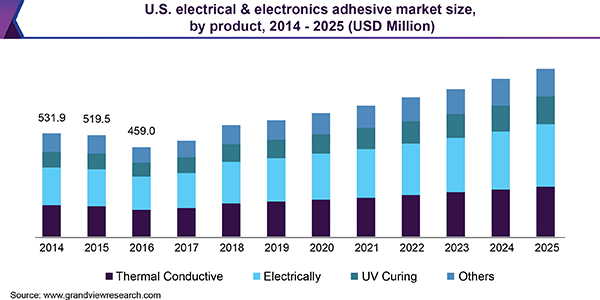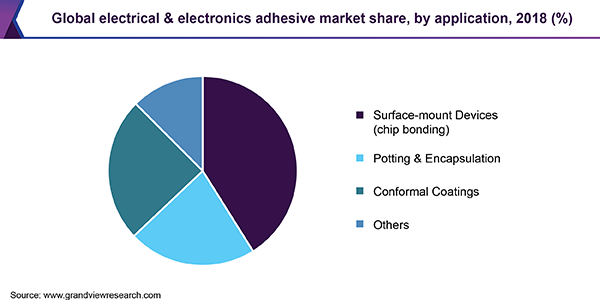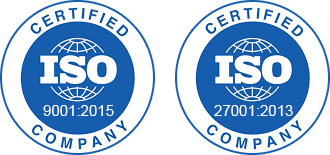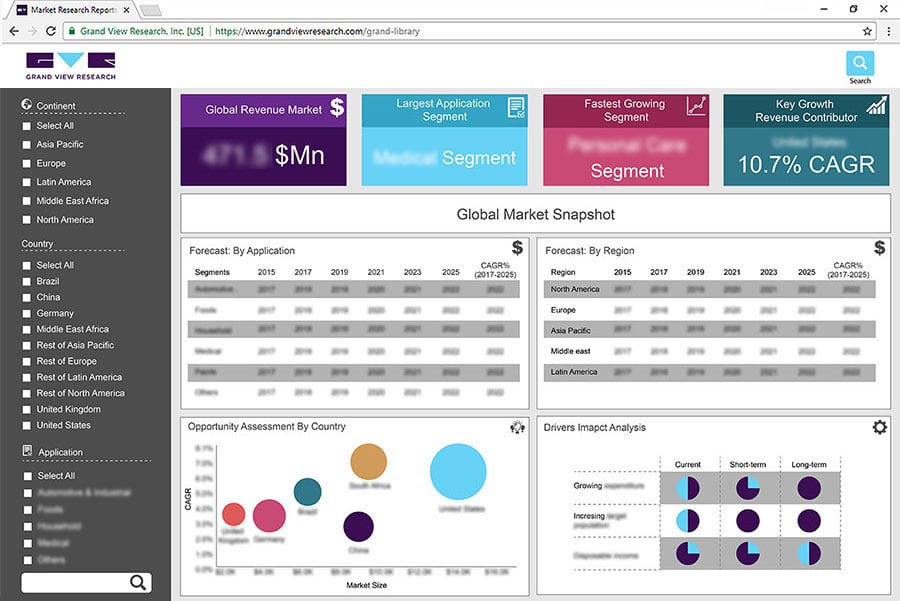- Home
- »
- Plastics, Polymers & Resins
- »
-
Electrical & Electronics Adhesives Market Size, Industry Report, 2025GVR Report cover
![Electrical & Electronics Adhesives Market Size, Share & Trends Report]()
Electrical & Electronics Adhesives Market Size, Share & Trends Analysis Report By Product (Thermal Conductive, Electrically Conductive), By Application, By Region, And Segment Forecasts, 2019 - 2025
- Report ID: 978-1-68038-492-5
- Number of Report Pages: 150
- Format: PDF, Horizon Databook
- Historical Range: 2014 - 2017
- Forecast Period: 2019 - 2025
- Industry: Bulk Chemicals
Industry Insights
The global electrical & electronics adhesives market size was valued at USD 4.3 billion in 2018 and is expected to witness a CAGR of 6.7% from 2019 to 2025. The expansion of the electrical & electronics industry owing to several innovations and increasing sales of consumer electronics products is driving the demand for adhesives.
Electrical & electronics sector is witnessing prominent changes owing to increasing production capacities and incessant investments in R&D. Further, the market is currently observing a growing demand for electrical & electronics devices both in developed and developing economies. Low operations and labor costs for manufacturing, particularly in China, are assisting the production of various products and equipment.

The popularity of medical devices and wearables is increasing at a rapid pace. Increased requirement of adhesives for bonding various assemblies in medical devices is expected to fuel the market growth over the forecast period. Acrylic electrical & electronics adhesives have performance characteristics that help lower the total cost of equipment and reduce time-consuming procedures involved in manufacturing electrical & electronics.
Over the past few years, adhesives are replacing various fastening systems in medical sector. Products such as pressure-sensitive, structural, and non-structural adhesives are used in numerous applications. Without any surface preparation, substrates such as plastic, rubber, and metal can be glued with the help of bonding products such as adhesives.
The market is majorly driven by the rising demand for adhesives from printed circuit boards (PCBs). Applications such as wire tracking, potting & encapsulation of components, conformal coatings of circuit boards, and bonding of surface mount components require various types of products such as adhesives for bonding purposes. Increased demand for computers, laptops, smartphones, household appliances, industrial & power equipment, control & navigation systems, and aerospace monitoring & testing equipment requires a massive number of adhesive products. Growing demand for these products is likely to benefit the electrical & electronics adhesives market over the forecast period.
Product Insights
Thermal conductive products segment was valued at USD 1.3 billion in 2018. Heat-related challenges in components can cause failure in electrical & electronic devices. Thermal conductive products in such cases provide heat-conducting paths and resist increasing heat. Silicone, epoxy, and acrylic are some of the common resin types used in the products.
In terms of volume, the electrically conductive product segment is projected to advance at a CAGR of 6.2% from 2019 to 2025. Applications such as surface mount devices and integrated circuits require electrical conductivity to ensure proper functioning. Improved efficiency and cost-effectiveness of the product are projected to contribute to market growth.
UV curing product segment is projected to grow at the fastest pace over the forecast period. High-performance electrical & electronics devices require good insulation properties and thermal conductivity, which is likely to benefit the growth of this segment. Other products in this segment include polyimides, silicone, and cyanoacrylates.
Application Insights
In terms of volume, surface mount devices were the largest application segment and accounted for 43.2% of the market share in 2018. The expansion of electrical & electronics manufacturing sector around the world is a primary key factor contributing to the demand for adhesives. As per the Japan Electronics and Information Technology Industries Association (JEITA), the global production of electronics and IT industry was valued at USD 2,930 billion in 2018.

The product is projected to witness growing demand from fly-back transformers, automotive power trains, and relays. In terms of revenue, potting & encapsulation segment is poised to progress at a lucrative CAGR of 6.9% from 2019 to 2025. Environment-related issues during post-assembly cleaning may break down solder bonds. Exposure to harsh temperature and pressure conditions weakens a solder bond. To overcome such challenges manufacturers have started using environment-friendly adhesives with high bond strength.
Regional Insights
Various suppliers have been focusing on providing cost-effective driver-assistance systems (ADAS) for medium-sized and compact car segments. New car assessment programs in Asia Pacific and Europe have been mandating various systems such as lane departure warning and automatic emergency braking. Asia Pacific emerged as the largest regional market and accounted for 734.1 kilotons, in terms of volume, in 2018.
Increased production of electrical & electronics in India, Japan, and China is likely to benefit the consumption of bonding products such as adhesives. For instance, as per JEITA, the production of electricals & electronics in Japan is expected to observe 1% year on year growth in 2019. In Japan, factors such as workstyle reforms, strong printers, and computers demand and consumption of electrical equipment in vehicles are projected to positively impact the growth of the sector.
In terms of revenue, North America market is anticipated to advance at a CAGR of 6.1% over the forecast period. High requirement to manage precision and protection of electronic components in display and telecommunication devices is a major factor responsible for the demand for electronic adhesives. Increasing demand for electronics in military and aerospace applications is expected to drive the demand for adhesives in this regional market.
Electrical & Electronics Adhesive Market Share Insights
Market participants are expected to focus on environment-friendly adhesive products over the coming years. Many producers are developing new materials and formulations to withstand ultra-high temperatures. The market is highly competitive as numerous manufacturers are increasing their production capacities across various countries.
Technological advancements in electrical & electronics coupled with R&D investment are expected to benefit the players to gain a competitive edge in the market. Some of the participants include 3M Company, H.B. Fuller, Henkel AG & Company, Dow, Evonik, and Masterbond.
Report Scope
Attribute
Details
Base year for estimation
2018
Actual estimates/Historic data
2014 - 2017
Forecast period
2019 - 2025
Market representation
Volume in Kilotons, Revenue in USD Million, & CAGR from 2019 to 2025
Regional scope
North America, Europe, Asia Pacific, Central & South America, and the Middle East & Africa
Country scope
U.S., Germany, Italy, France, China, India, and Japan
Report coverage
Revenue forecast, company share, competitive landscape, growth factors, and trends
15% free customization scope (equivalent to 5 analyst working days)
If you need specific information, which is not currently within the scope of the report, we will provide it to you as a part of customization
Segments Covered in the ReportThis report forecasts revenue growth at the global, regional, and country levels and provides an analysis of the industry trends in each of the sub-segments from 2014 to 2025. For the purpose of this study, Grand View Research has segmented the global electrical & electronics adhesives market report based on product, application, and region:
-
Product Outlook (Volume, Kilotons; Revenue, USD Million, 2014 - 2025)
-
Thermal Conductive
-
Electrically Conductive
-
UV Curing
-
Others
-
-
Application Outlook (Volume, Kilotons; Revenue, USD Million, 2014 - 2025)
-
Surface-mount devices (chip bonding)
-
Potting & Encapsulation
-
Conformal Coatings
-
Others
-
-
Regional Outlook (Volume, Kilotons; Revenue, USD Million, 2014 - 2025)
-
North America
-
The U.S.
-
-
Europe
-
Germany
-
France
-
Italy
-
-
Asia Pacific
-
China
-
India
-
Japan
-
-
Central and South America
-
Middle East & Africa
-
Share this report with your colleague or friend.
![gvr icn]()
NEED A CUSTOM REPORT?
We can customize every report - free of charge - including purchasing stand-alone sections or country-level reports, as well as offer affordable discounts for start-ups & universities. Contact us now
![Certified Icon]()
We are GDPR and CCPA compliant! Your transaction & personal information is safe and secure. For more details, please read our privacy policy.
We are committed towards customer satisfaction, and quality service.
"The quality of research they have done for us has been excellent."





